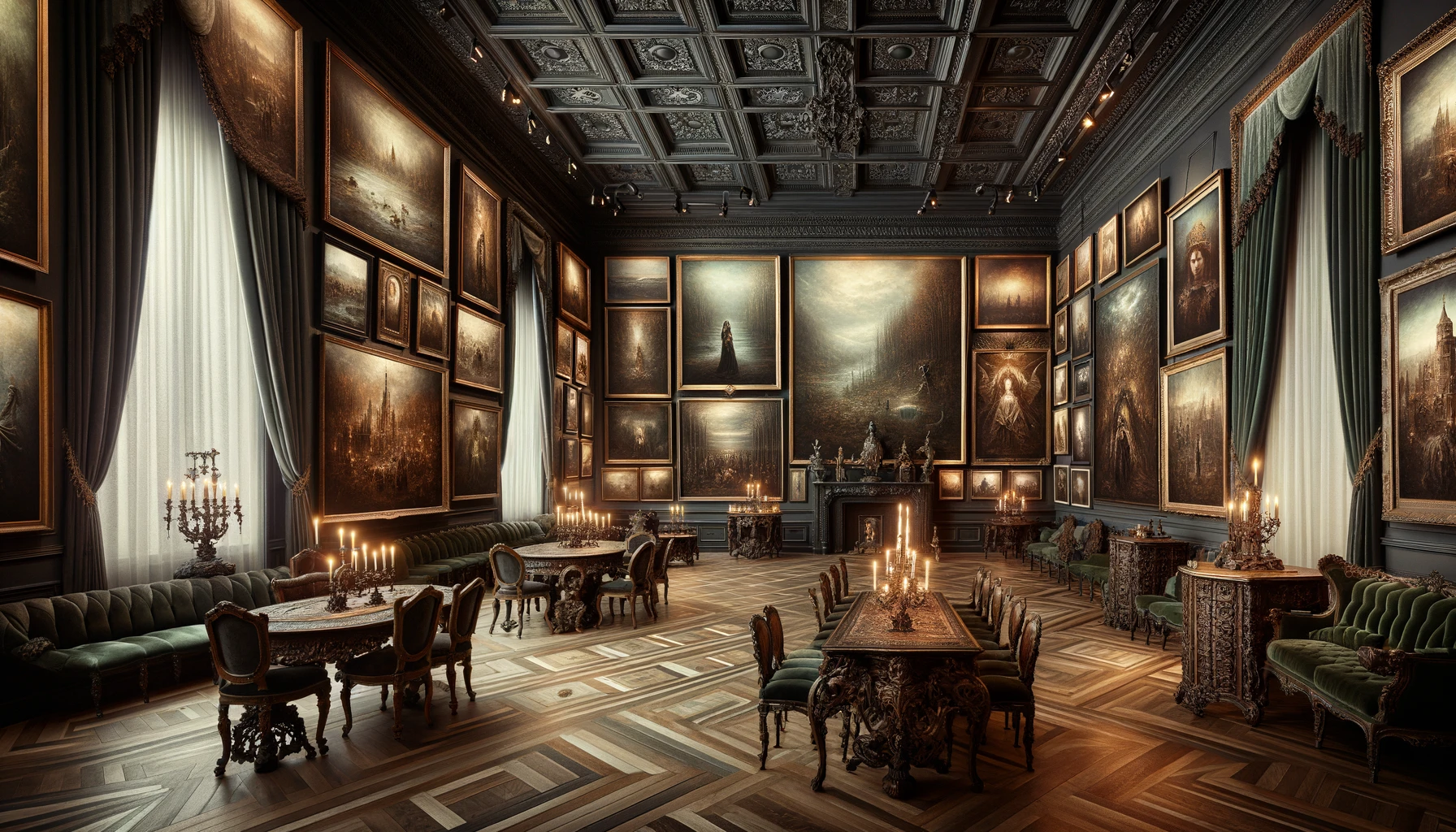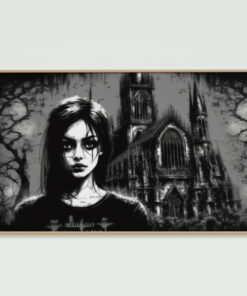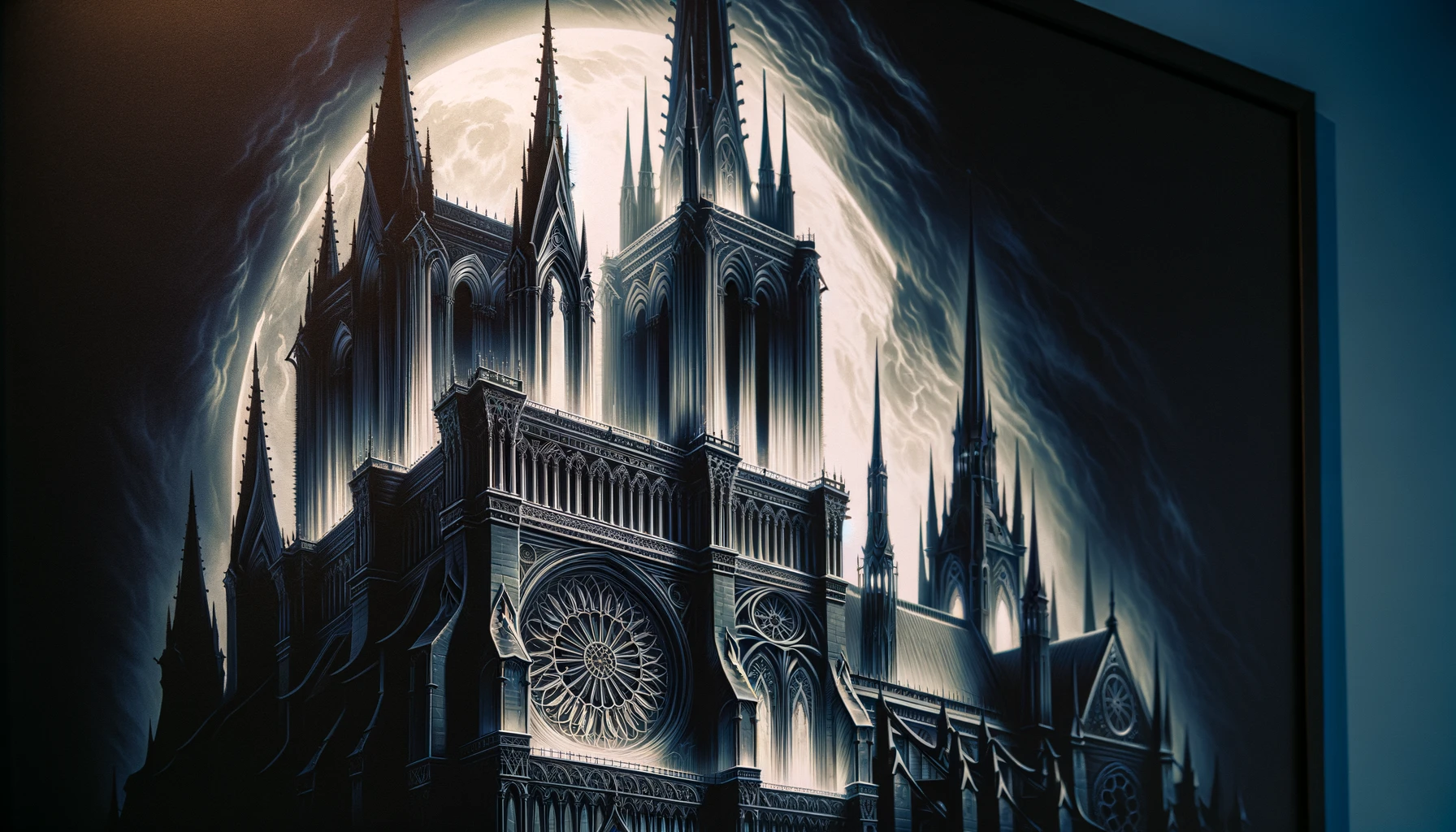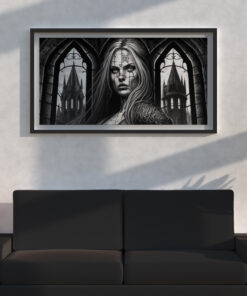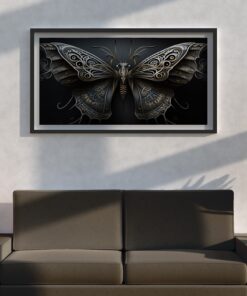
Shadows on the Wall: Exploring Gothic Wall Art
Gothic wall art, a term that evokes images of shadowy figures, ancient ruins, and the mystique of the medieval era, has carved a niche for itself in the realm of decorative arts. This art form, steeped in history and rich in symbolism, transcends mere aesthetic appeal, offering a window into a world where darkness and beauty coalesce. It beckons the viewer into a realm where the past is palpably present, where gothic arches and stained glass designs are not just seen but felt, enveloping the onlooker in an atmosphere thick with mystique and allure.
The Resurgence of Gothic Wall Art

In contemporary decor, Gothic wall art has witnessed a resurgence, with enthusiasts embracing its dark, romantic themes as a means to inject depth and character into their living spaces. This revival is not merely about revisiting the gothic motifs of yore but reinterpreting them, blending traditional elements with modern sensibilities to create spaces that feel both timeless and distinctly personal.
The Essence of Gothic Wall Art

Defining Gothic Wall Art
At its core, Gothic wall art embodies more than just the visual representations of the gothic tradition; it is a conduit for expressing the complex interplay of beauty and decay, of light amidst darkness. It is characterized by its thematic depth, intricate designs, and a palette that often veers towards the darker end of the spectrum, yet always with a hint of color to breathe life into the compositions.
Historical Roots
The gothic style, originating in the 12th century, was first seen in the architecture of the time, with its pointed arches, ribbed vaults, and flying buttresses. As it evolved, it found expression in various forms of art, including wall art, where the stylistic elements of gothic architecture were reimagined on canvas and stone.
Evolution into Wall Art
As Gothic wall art transitioned from the architectural to the pictorial, it retained its fundamental elements—symbolism, detailed craftsmanship, and a penchant for themes that delve into the mystical and supernatural. Today, it encompasses a wide range of media, from traditional oil paintings to digital creations, each piece echoing the gothic fascination with the interplay between shadow and light, mortality, and the divine.
Characteristics of Gothic Wall Art
- Dark Themes and Motifs: Gothic art is renowned for its exploration of themes like mortality, the supernatural, and the macabre, often presented in a visually rich and symbolic manner.
- Rich Symbolism: Symbols such as skulls, ravens, and ruins are not mere decorative elements but carry deep meanings, touching on themes of life, death, and the beyond.
- Intricate Designs: The complexity and attention to detail in Gothic art are unmatched, with artists weaving a tapestry of visual elements that captivate and intrigue.
- Color Schemes: While predominantly dark, the color palette of Gothic wall art is carefully chosen to evoke specific moods and highlight key elements within the artwork, often using contrasts to draw the viewer’s eye.
Gothic wall art, with its deep roots and evolving nature, continues to enchant and engage, offering a unique blend of historical depth and contemporary appeal. It stands as a testament to the enduring allure of the gothic aesthetic, inviting us to explore the shadows and discover the beauty that lies within.
Explore the depths of darkness and elegance with our curated selection at our Gothic Wall Art.
Key Elements of Gothic Art

Gothic wall art is a celebration of the ethereal, the macabre, and the profoundly symbolic. Its allure lies in its complexity and the depth of its thematic and visual elements, which draw heavily on the historical and cultural roots of the Gothic tradition.
Dark Themes and Motifs
At the heart of Gothic art are its dark themes, which explore the depths of human emotion, the mysteries of the supernatural, and the beauty found in decay. These themes are not only captivating in their storytelling but are also rich in symbolism, offering layers of meaning to be uncovered.
- Mortality and the Macabre: Gothic art frequently delves into topics of death and the afterlife, not as morbid fascinations but as reflections on the human condition.
- Supernatural Elements: Ghosts, vampires, and other ethereal beings feature prominently, serving as metaphors for deeper themes of longing, loss, and the unknown.
- Melancholy and Romance: The emotive power of Gothic wall art often lies in its portrayal of melancholy and romantic despair, inviting contemplation of love and loss.
Rich Symbolism
Symbolism is the language of Gothic art, through which it communicates its deepest themes and messages.
- Architectural Elements: Gothic arches, cathedrals, and ruins are not just backgrounds but symbols of the divine and the passage of time.
- Nature and Decay: Trees, flowers, and landscapes in states of bloom or decay mirror themes of life, death, and rebirth.
- Iconic Symbols: Skulls, ravens, and candles appear frequently, each adding layers of meaning related to fate, wisdom, and enlightenment.
Intricate Designs
The complexity of Gothic art is evident in its detailed craftsmanship. Artists spend countless hours creating pieces that are visually rich and meticulously detailed, inviting viewers to look closer and discover the hidden depths within.
- Texture and Depth: The use of texture in Gothic art adds a tangible feel to the ethereal subjects, creating a sense of depth and realism.
- Pattern and Ornamentation: Detailed patterns and ornamental designs are hallmarks of the Gothic style, adding elegance and complexity to the artwork.
Color Schemes
The color palette of Gothic wall art is carefully curated to evoke specific emotions and highlight the artwork’s themes.
- Dark Hues: Blacks, grays, and deep purples dominate, creating a somber mood that enhances the artwork’s mysterious qualities.
- Contrasting Colors: Strategic use of bright colors against dark backgrounds serves to highlight key elements, drawing the viewer’s attention to the heart of the story being told.
Popular Themes in Gothic Wall Art
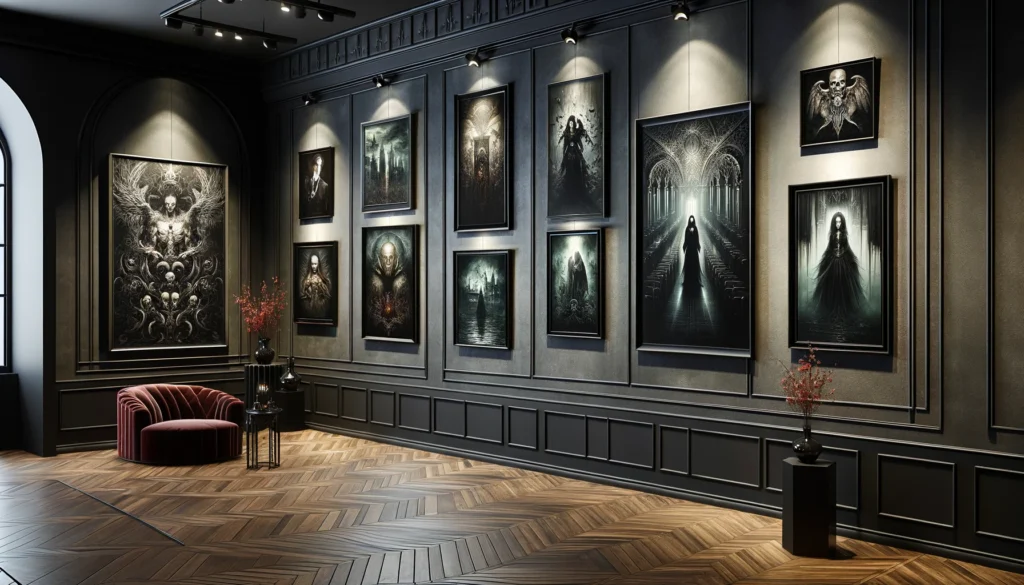
Gothic wall art draws upon a rich tapestry of themes, each offering a window into the sublime, the mysterious, and the profound. These themes not only reflect the historical roots of the Gothic tradition but are also deeply resonant with contemporary audiences.
Medieval Fantasies
The allure of the medieval is a cornerstone of Gothic art, with its castles, knights, and mythical creatures evoking an era of heroism and legend.
- Chivalry and Adventure: Scenes of knights and damsels reflect the romanticized view of the medieval past.
- Mythical Creatures: Dragons, griffins, and other mythical beings symbolize the power of the imagination and the unknown.
Gothic Architecture
The architectural elements of the Gothic period lend themselves beautifully to wall art, serving as both subject and symbol.
- Cathedrals and Churches: These structures, with their towering spires and intricate windows, symbolize the divine and the eternal.
- Ruins and Relics: Depictions of ruins evoke a sense of nostalgia and reflection on the passage of time and the impermanence of man’s creations.
Supernatural Elements
The supernatural is a recurring theme in Gothic art, exploring the boundaries between the known and the unknown, the seen and the unseen.
- Ghosts and Spirits: These entities are often used to explore themes of loss, redemption, and the afterlife.
- Vampires and Werewolves: Representations of these creatures delve into themes of desire, power, and the duality of human nature.
Romanticism
The theme of romanticism in Gothic art is expressed through depictions of intense emotion, untamed nature, and the tumultuous landscapes of the human heart.
- Love and Despair: Artworks often portray star-crossed lovers or solitary figures, embodying the romantic ideal of profound, often unattainable, love.
- Beauty in Darkness: This theme celebrates the aesthetic of decay and the beauty to be found in dark, desolate landscapes.
Gothic wall art, with its intricate designs, rich symbolism, and captivating themes, invites viewers into a world where the past whispers to the present, where mystery and beauty walk hand in hand. Through its exploration of dark themes, supernatural elements, and the romantic sublime, it offers a profound commentary on the human condition, inviting us to look beyond the surface and explore the depths of our own imaginations.
Materials and Techniques
The creation of Gothic wall art is a meticulous process that involves a variety of materials and techniques. Artists dedicated to this genre employ both traditional and modern methods to bring their dark, intricate visions to life, ensuring each piece resonates with the depth and complexity characteristic of the Gothic aesthetic.
Traditional Materials
- Canvas and Oil Paint: Many Gothic artists prefer the classic combination of canvas and oil paints for their work. Oil paints offer a richness of color and texture that is particularly suited to the detailed and atmospheric qualities of Gothic art.
- Wood Panels: Historically, wood panels were a common medium for Gothic paintings. The texture of wood adds a unique depth to the artwork, enhancing its visual impact.
- Metal and Glass: In homage to the Gothic architectural tradition, some artists incorporate metal and stained glass into their work, creating pieces that reflect the light and shadow play so integral to the Gothic mood.
Modern Materials
- Acrylics and Digital Media: The use of acrylic paints and digital media has opened new avenues for artists to explore Gothic themes. These materials allow for greater experimentation with color and detail, enabling artists to craft pieces that are both vibrant and deeply evocative of Gothic sensibilities.
- Mixed Media: Combining various materials, such as paper, fabric, and found objects, with traditional painting techniques, artists can create textured, layered pieces that are rich in symbolism and meaning.
Techniques
Layering
Layering is a fundamental technique in the creation of Gothic wall art, used to build up depth and intensity in the artwork. By applying multiple layers of paint or incorporating different materials, artists can create a sense of dimensionality and complexity that enhances the visual and emotional impact of their work.
Detailing
The intricate detailing characteristic of Gothic art is achieved through meticulous brushwork and the careful application of color and light. Artists spend hours, sometimes days, adding the minute details that bring their Gothic visions to life, ensuring that each element, no matter how small, contributes to the overall atmosphere of the piece.
Color Contrast
Contrast plays a crucial role in Gothic wall art, with artists often employing stark contrasts between light and dark hues to highlight key elements of their work and create a dramatic visual effect. This technique not only draws the viewer’s eye but also emphasizes the themes of duality and conflict so central to the Gothic aesthetic.
Incorporating Gothic Wall Art into Home Decor
-
Gothic Wall Art Banshee’s Wail
-
Gothic Wall Art Crimson Temptress
-
Gothic Wall Art Infernal Goddess Lilith
$29.99 – $119.99
Integrating Gothic wall art into home decor requires a thoughtful approach to balance and placement. The unique aesthetic of Gothic art can transform a space, imbuing it with depth, character, and a touch of the mystical.
Choosing the Right Space
- Personal Sanctuaries: Bedrooms, studies, and personal offices are ideal spaces for Gothic art, providing a backdrop that inspires contemplation and creativity.
- Common Areas: In living rooms or dining areas, a single, striking piece of Gothic wall art can serve as a focal point, sparking conversation and drawing the eye.
Balancing Gothic Elements with Modern Decor
- Complementary Colors: Incorporating decor elements that match or complement the color palette of the Gothic artwork can help unify the space.
- Mixing Styles: Pairing Gothic art with modern or minimalist furniture can create a visually striking contrast, highlighting the artwork while maintaining a clean, contemporary feel.
Lighting Considerations
- Ambient Lighting: Soft, ambient lighting can enhance the moody atmosphere of Gothic wall art, accentuating its details and colors.
- Spotlighting: Using directed lights to spotlight the artwork can draw attention to its intricate details and textures, making it a standout feature of the room.
Incorporating Gothic wall art into home decor not only adds a visual interest but also invites the mystical and historic into everyday spaces. By carefully selecting the right pieces and considering their placement and the surrounding decor, it is possible to create a harmonious blend of the Gothic and the contemporary, transforming a home into a canvas that reflects the depth and richness of the Gothic tradition.
DIY Gothic Wall Art Projects
Creating your own Gothic wall art offers a personal touch to your living space, allowing you to imbue your home with the dark, romantic allure of the Gothic aesthetic through a hands-on approach. Here are some DIY projects to help you craft your own pieces, showcasing your individual take on this timeless style.
Stencil Art
Materials Needed
- Stencils with Gothic motifs: Choose designs that resonate with Gothic themes, such as arches, skulls, or mythical creatures.
- Spray paint or acrylics: Opt for dark hues like black, deep purple, or blood red to stay true to the Gothic palette.
- Canvas or heavy paper: Select a medium that will complement your chosen paint type and provide a sturdy backdrop for your artwork.
Steps
- Prepare Your Workspace: Lay down newspapers or a drop cloth to protect your surface.
- Secure the Stencil: Tape the stencil to your canvas or paper to keep it in place while you work.
- Apply Paint: Use spray paint or a brush to apply paint over the stencil. For a more layered effect, consider using multiple colors.
- Reveal Your Art: Carefully remove the stencil to unveil your Gothic creation.
Mixed Media Collage
Materials Needed
- Base material: A piece of wood or a stretched canvas works well as a foundation.
- Gothic imagery: Collect printed images, old book pages, or fabric with Gothic patterns.
- Adhesives: Use mod podge or glue suitable for your materials.
- Decorative elements: Consider adding lace, pressed flowers, or metal charms to enhance the Gothic vibe.
Steps
- Arrange Your Design: Before gluing, lay out your imagery and elements on the base to plan your composition.
- Apply Adhesive: Begin gluing your pieces down, layering as you go to create depth.
- Add Textures: Incorporate different textures through fabric, lace, or even painting techniques to give your collage a tactile quality.
- Final Touches: Once the glue has dried, add any final embellishments to complete your Gothic masterpiece.
Interview with a Gothic Wall Art Artist
To gain deeper insight into the world of Gothic wall art, we spoke with a contemporary artist renowned for their contributions to the genre. They shared their inspiration, process, and advice for aspiring artists drawn to the Gothic aesthetic.
Inspiration
The artist draws inspiration from a variety of sources, including Gothic architecture, literature, and the natural world. They emphasize the importance of history and storytelling in their work, aiming to create pieces that not only captivate visually but also evoke the rich, layered narratives inherent to the Gothic tradition.
Creative Process
- Conceptualization: Each piece begins with a concept, often inspired by a piece of literature or a historical theme.
- Sketching: Preliminary sketches help flesh out the idea, exploring composition and key elements.
- Execution: Using a combination of traditional and modern techniques, the artist brings their vision to life, paying meticulous attention to detail and mood.
Advice for Aspiring Artists
- Explore History: Understanding the historical roots of the Gothic can provide a rich foundation of inspiration.
- Experiment: Don’t be afraid to try different materials and techniques to find your unique voice within the Gothic genre.
- Be Patient: The complexity of Gothic art requires time and patience, both in honing your skills and in executing your vision.
This interview provides a valuable perspective on the creation of Gothic wall art, highlighting the blend of inspiration, dedication, and creativity that defines the genre. For those drawn to the dark beauty of the Gothic, these insights offer encouragement and guidance on the path to creating their own hauntingly beautiful artworks.
Gallery: Inspirational Gothic Wall Art Pieces
A curated selection of Gothic wall art serves not only as a source of inspiration but also as a showcase of the diversity and depth within the genre. Each piece, selected for its unique interpretation of Gothic themes, offers a glimpse into the myriad ways artists can explore darkness, beauty, and the mystical through their work.
“Whispers from the Abbey” by Elena Moroz
- Medium: Oil on Canvas
- Dimensions: 24×36 inches
- Description: This piece captures the haunting beauty of a desolate Gothic abbey at twilight. Moroz skillfully employs a palette of deep blues and purples, punctuated by the stark contrast of the moonlight streaming through the broken windows. The intricate detail of the crumbling stone and the ethereal glow create a sense of serenity amidst decay.
“The Guardian” by Marcus Stone
- Medium: Acrylics and Ink on Wood Panel
- Dimensions: 18×24 inches
- Description: Stone’s work features a mythical creature perched atop a Gothic cathedral, surveying the city below. The creature, a blend of dragon and gargoyle, is rendered in exquisite detail, with scales that shimmer against the backdrop of a starlit sky. The piece embodies the protective spirits of Gothic architecture, watching over the city through the ages.
“Veil of Shadows” by Lila Taylor
- Medium: Digital Art
- Dimensions: Available in various sizes
- Description: Taylor’s digital creation delves into the supernatural, depicting a ghostly figure shrouded in a dark veil, standing before an ancient tomb. The use of light and shadow is particularly striking, with the figure emerging from the darkness as if caught in a moment of transition between worlds. The artwork invites contemplation of the thin veil between life and death.
“Eternal Embrace” by Alexei Petrov
- Medium: Mixed Media on Canvas
- Dimensions: 30×40 inches
- Description: Petrov combines traditional painting with elements of collage to depict two lovers locked in an embrace that transcends time. The background, a collage of old letters and photographs, adds a layer of nostalgia and depth, suggesting a love story that echoes through the ages. The lovers, painted in monochromatic tones, stand as a stark contrast to the vivid memories behind them.
Caring for and Preserving Gothic Wall Art
-
Gothic wall art Annabelle
$29.99 – $119.99 -
Gothic Wall Art black and white
$29.99 – $119.99 -
Gothic Wall Art Butterfly Shadowed Wings
$29.99 – $119.99
Maintaining the integrity and beauty of Gothic wall art requires specific care and preservation techniques, ensuring that these pieces continue to captivate and inspire for years to come.
Avoiding Direct Sunlight
- Impact: Prolonged exposure to direct sunlight can fade and damage artwork, diminishing its colors and details.
- Prevention: Positioning art away from direct sunlight or using UV-protective glass when framing can help preserve the artwork’s vibrancy.
Regular Dusting and Cleaning
- Dusting: Gentle dusting with a soft, dry cloth can prevent the accumulation of dust, which can obscure details and dull the artwork’s finish.
- Cleaning: For more thorough cleaning, it’s crucial to use products that are safe for the specific materials of the artwork. Avoid harsh chemicals or abrasive materials that could damage the surface.
Proper Framing and Display
- Framing: High-quality framing not only enhances the presentation of Gothic wall art but also provides protection from environmental factors. Using acid-free mats and backing materials can prevent deterioration over time.
- Display: Ensuring that the artwork is securely mounted on the wall can prevent accidental damage. Using proper hanging techniques and materials suitable for the artwork’s weight and size is essential.
By adhering to these care and preservation guidelines, collectors and enthusiasts can ensure that their Gothic wall art remains a striking feature of their home decor, retaining its beauty and mystique for future generations to appreciate.
Conclusion
-
Gothic Wall Art Catacombs of Paris Enigma
-
Gothic Wall Art Enigma of the Night
-
Gothic Wall Art Eternal Sanctum
$29.99 – $119.99
In delving into the shadowy realms of Gothic wall art, we’ve traversed through its historical roots, explored its key elements, and admired its thematic diversity. This journey has not only highlighted the aesthetic depth and emotional resonance of Gothic art but also its enduring appeal in contemporary decor. Gothic wall art invites us into a world where darkness coalesces with beauty, where the mystical and the mortal intertwine, offering a profound reflection on the human condition and our fascination with the beyond.
Embracing Gothic wall art in our living spaces allows us to make a bold statement, one that honors the complexity of life and the myriad emotions that color our existence. It challenges us to find beauty in the unconventional and to appreciate the rich tapestry of history and imagination that Gothic art weaves.FAQs About Gothic Wall Art
What is Gothic Wall Art?
Gothic wall art encompasses a wide range of artistic expressions rooted in the Gothic tradition, characterized by its dark themes, rich symbolism, and intricate designs. It draws inspiration from medieval, supernatural, and romantic elements, offering a unique blend of the historical and the fantastical.
How Can I Incorporate Gothic Wall Art into Modern Decor?
Incorporating Gothic wall art into modern decor involves balancing the artwork’s dark and dramatic essence with the existing style of your space. It can serve as a focal point in a room or complement a theme, with careful consideration of placement, lighting, and surrounding elements to ensure harmony and cohesion in your decor.
Where Can I Find Gothic Wall Art?
Gothic wall art can be found in various venues, from art galleries and online marketplaces to specialty stores that cater to Gothic and alternative styles. Additionally, creating your own Gothic art pieces allows for a personal touch and a deeper connection to the aesthetic.
How Do I Care for and Preserve Gothic Wall Art?
Caring for Gothic wall art involves protecting it from direct sunlight, maintaining an appropriate environment free from excessive humidity and dust, and using proper cleaning techniques tailored to the artwork’s materials. Regular maintenance and careful handling can ensure the longevity and beauty of your Gothic art pieces.
Can Gothic Wall Art Fit Any Room?
Yes, Gothic wall art can complement any room, depending on the chosen piece and how it’s integrated into the space. Whether it’s a bedroom, living area, or study, Gothic art can add depth, interest, and a touch of the enigmatic, provided it’s balanced with the room’s overall aesthetic and ambiance.
By addressing these common questions, we aim to demystify Gothic wall art and encourage individuals to explore this captivating art form, whether through acquisition, creation, or simply deepening their appreciation for its profound beauty and complexity.
Resources and Further Reading
For enthusiasts eager to delve deeper into the enigmatic world of Gothic wall art, a wealth of resources awaits. From historical analyses to contemporary collections, the following resources offer insights, inspiration, and guidance for those captivated by the dark beauty of the Gothic tradition.
Books and Publications
- “Gothic Art: Visions and Revelations of the Medieval World” by Sarah Lynch
- An in-depth exploration of Gothic art’s origins, evolution, and enduring influence, featuring stunning illustrations of Gothic architecture, sculpture, and illuminated manuscripts.
- “Dark Spirits: The Art of the Gothic” by Ann Davies
- This book offers a comprehensive look at the Gothic aesthetic across various media, including literature, film, and visual arts, providing context for the themes and motifs prevalent in Gothic wall art.
- “The Gothic: A Very Short Introduction” by Nick Groom
- A concise overview of the Gothic genre, tracing its roots from ancient times to its manifestation in contemporary culture, ideal for newcomers seeking a foundational understanding of Gothic themes.
Online Resources
- The Gothic Library
- An online repository of Gothic literature, art, and history, offering articles, reviews, and an extensive collection of Gothic works accessible to the public.
- ArtStation – Gothic Art Category
- A platform where contemporary artists showcase their work, including a category dedicated to Gothic art, featuring digital and traditional pieces by emerging and established artists.
- Gothic Beauty Magazine
- A publication covering the Gothic subculture, including fashion, music, and art, with features on artists and galleries specializing in Gothic wall art.
Galleries and Exhibitions
- The Metropolitan Museum of Art – Medieval Art and The Cloisters
- The Met in New York City offers an impressive collection of medieval art, including Gothic pieces, with periodic exhibitions and a permanent collection accessible both in-person and online.
- The Victoria and Albert Museum – Gothic Revival
- Located in London, the V&A Museum showcases the Gothic Revival movement, offering insights into how Gothic art and architecture influenced later periods, including contemporary Gothic wall art.
Workshops and Courses
- Local Art Classes and Workshops
- Many community centers, colleges, and art schools offer workshops focused on Gothic art techniques, from traditional painting to digital art creation.
- Online Art Platforms
- Websites like Skillshare, Udemy, and Coursera offer courses on Gothic art history and creation, catering to various skill levels and interests.
By engaging with these resources, individuals can enrich their understanding and appreciation of Gothic wall art, gaining insights into its historical roots, thematic complexity, and the myriad ways it continues to inspire artists and enthusiasts around the globe. Whether through academic study, creative exploration, or simple admiration, the journey into the Gothic offers endless possibilities for discovery and inspiration.
